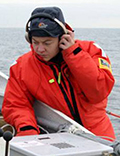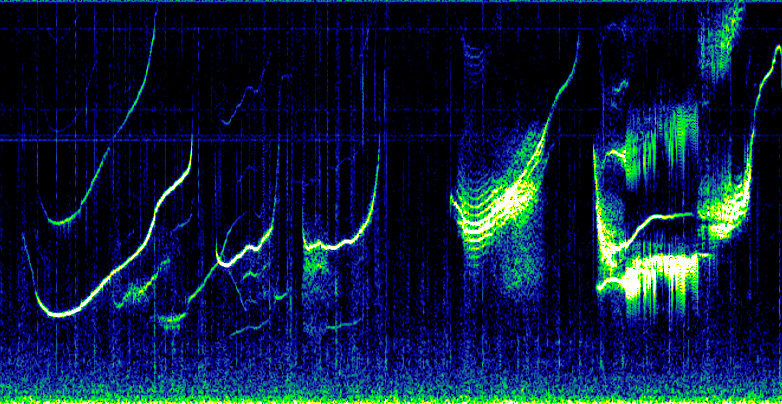Bioacoustics
This program is a collaboration between the NOAA Northeast Fisheries Science Center and Woods Hole Sea Grant.
Background
Light is very limited in the ocean habitat. Below the photic zone (the depth to which sunlight is able to penetrate) it is very dark. For marine mammals, however, this vast 3-dimensional world is far from dark. The ocean is illuminated by sound, which travels much farther than light underwater. The sounds of waves and storms at the surface, of earthquakes and underwater landslides, of schooling fish, and of other marine mammals fill the underwater world.
Marine mammals use these natural sounds and sounds that they produce for just about every aspect of their lives. For example, ice seals use the sounds of ice cracking and sounds transmitting from the air above to locate their breathing holes in the ice. Baleen whales use the sounds of waves crashing on the shoreline to help in navigation during their migration. Some whales use echolocation to locate prey or detect objects. All marine mammals use sound to communicate with each other.
In this lesson, students will be learning about the importance of sound to marine mammals. They will explore how information can be gained from sound, familiarize themselves with the sounds made by various species of marine mammals, and discover how hard it is to communicate when there is a lot of anthropogenic (man-made) noise. They will see how humans have affected marine mammal acoustics and what they can do to make a difference.
Lesson Plans
Graces K-6
Activity Sheets/Handouts
"Whose sound is it?" Activity Cards
Whale Morse Code Activity Strips
This lesson meets the following Next Generation Science Standards:
- Grades K-2:
- K-ESS3-3 - Communicate solutions that will reduce the impact of humans on other living things in the local environment. This lesson introduces students to the Right Whale Listening Network and encourages students to think of ways to minimize their impact on local waters and marine mammal species.
- 1-LS1-2 - Read texts and use media to determine patterns in behavior of parents and offspring that help offspring survive. This lesson encourages the students to explore why marine mammals rely so heavily on sound and how that enables them to communicate a variety of information to other individuals as well as their offspring.
- 2-LS4-1 - Make observations of plants and animals to compare the diversity of life in different habitats. This lesson allows the students to observe the various adaptations marine mammals possess that allow them to send and receive sound much more efficiently than many terrestrial mammals. They can also make comparisons between marine mammal species that may be found at different locations in the water column.
- Grades 3-5:
- 3-LS2-1 - Construct an argument that some animals form groups that help members survive. In this lesson students explore the importance of a whale pod and how bioacoustics is an integral part in pod health.
- 4-LS1-2 - Use a model to describe that animals receive different types of information through their senses, process the information in their brain, and respond to the information in different ways. In this lesson students discover why sound is so important in the ocean and leads to resultant behavior in marine mammals.
- 5-ESS3-1 - Obtain and combine information about ways individual communities use science ideas to protect the Earth's resources and environment. Students will discover how sound can be used to monitor local whale species as well as protect them from ship strikes.
Additional Resources
- Northeast Fisheries Science Center sounds in the ocean page: Listen to marine mammals sounds and view species fact sheets.
- Voices in the Sea: Listen to cetacean and pinniped sounds!
- Macaulay Library: Cornell University's extensive archive of audio and video recordings for all types of animals.
- Right Whale Listening Network: Learn about North Atlantic Right Whales and how acoustic buoys can help prevent ship strikes.
- Scripps Institute of Oceanography bioacoustics page: Listen to marine bioacoustics and learn more about this area of research at Scripps.
- Voices in the Sea:: sounds game: Game to match each marine mammals to their call.
- Discovery of Sound in the Sea (DOSITS): A plethora of information, videos, and resources about the science and uses of sound in the sea.
- The World: Can you guess what makes this sound?
- Noise Tube: You can use your smart phone to monitor noise pollution yourself by participating in this research project started at the Sony Computer Science Laboratory Paris.
- Kids Do Ecology:: Santa Barbara: Humpback songs and videos as well as a quick explanation of how scientists record whale song.
- Bridge: Teacher approved marine education materials.
- NOAA/MML: Marine Mammal lab information on marine mammals and careers involving them.
- Smithsonian National Museum of Natural History: Ocean Portal for educators with some great videos and information.
This program is a collaboration between the NOAA Northeast Fisheries Science Center and Woods Hole Sea Grant.
Scientist Spotlight

Zoologist
Northeast Fisheries Science Center
Sofie studies the sounds that marine mammals make and evaluates how human-produced sounds impact these acoustically sensitive animals.

Research Specialist
Woods Hole Oceanographic Institution
Laela studies communication in whales and dolphins and worked on a project to develop an acoustic method to predict cetacean mass stranding events.




